Women Entrepreneurship: Challenges and Perspectives of an Emerging Economy
Abstract
1. Introduction
2. Study Background and Literature
3. Methodology
4. Results
4.1. Sample General Characteristics
4.2. Motivation behind Starting an Entrepreneurial Venture
4.3. Support vs. Discrimination
4.4. Level of Women Entrepreneurship Performance and Support vs. Discrimination: Testing of the Research Hypothesis
5. Discussions and Recommendations
6. Conclusions and Implications
- -
- Governments need to target concrete practices to facilitate the process of entrepreneurship, especially for women.
- -
- Other institutions, including nonprofit organizations, have to take an active role in organizing various trainings toward females.
- -
- Scholars have to further investigate the factors supporting women entrepreneurship and also helping to increase the public awareness with reference to this subject.
- -
- Banks can also act as a mediatory element in promoting women entrepreneurship by providing facilities for females applying for loans.
Author Contributions
Funding
Institutional Review Board Statement
Informed Consent Statement
Data Availability Statement
Conflicts of Interest
References
- Abel, Martin. 2019. Women Bosses Face More Discrimination (Both from Men and Women). Fast Company. October 18. Available online: https://www.fastcompany.com/90419052/women-bosses-and-gender-discrimination (accessed on 30 October 2022).
- Ahl, Helene. 2006. Why research on women entrepreneurs need new directions. Entrepreneurship: Theory and Practice 30: 595–621. [Google Scholar]
- Ahmeti, Eni, and Alba Demneri Kruja. 2020. Challenges and Perspectives of Supply Chain Management in Emerging Markets: A Case Study Approach. In Leadership Strategies for Global Supply Chain Management in Emerging Markets. Hershey: IGI Global, pp. 132–46. [Google Scholar]
- Ajjan, Haja, Stephanie Beninger, Rania Mostafa, and Victoria L. Crittenden. 2014. Empowering women entrepreneurs in emerging economies: A conceptual model. Organizations and Markets in Emerging Economies 5: 16–30. [Google Scholar] [CrossRef]
- Alite, Rexhina. 2013. Diskriminimi gjinor në menaxhimin e karrierës. Master of Science Thesis; pp. 1–42. Available online: https://www.uamd.edu.al/new/wp-content/uploads/2013/01/Diskriminimi-gjinor-n%C3%AB-menaxhimin-e-karrier%C3%ABs.pdf (accessed on 30 October 2022).
- Anderson, Alistair R., and Sara Drakopoulou. 2009. The role of family members in Entrepreneurial networks: Beyond the boundaries of the family firm. Family Business Review 18: 135–54. [Google Scholar] [CrossRef]
- Anderson, Alistair, and Funmi Ojediran. 2022. Perspectives, progress and prospects; researching women’s entrepreneurship in emerging economies. Journal of Entrepreneurship in Emerging Economies 14: 292–315. [Google Scholar] [CrossRef]
- Apostu, Simona Andreea, Lindita Mukli, Mirela Panait, Iza Gigauri, and Eglantina Hysa. 2022. Economic Growth through the Lenses of Education, Entrepreneurship, and Innovation. Administrative Sciences 12: 74. [Google Scholar] [CrossRef]
- Asllani, Arben, Richard Becherer, and Qirjako Theodhori. 2014. Developing a Sustainable Economy through Entrepreneurship: The Case of Albania. South-Eastern Europe Journal of Economics 12: 243–62. [Google Scholar]
- Avram, Gabriela, and Eglantina Hysa. 2022. Education, Knowledge and Data in the Context of the Sharing Economy. In The Sharing Economy in Europe. Cham: Palgrave Macmillan, pp. 181–206. [Google Scholar]
- Berhani, Riada, and Eglantina Hysa. 2014. The Economy of Albania Today and then: The Drivers to Growth. Paper presented at 4th International Conference on European Studies, Tirana, Albania, November 10; p. 598. [Google Scholar]
- Berisha, Anisa, Alba Kruja, and Eglantina Hysa. 2022. Perspective of Critical Factors toward Successful Public–Private Partnerships for Emerging Economies. Administrative Sciences 12: 160. [Google Scholar] [CrossRef]
- Bitzenis, Aristidis, and Ersanja Nito. 2005. Obstacles to entrepreneurship in a transition business environment: The case of Albania. Journal of Small Business and Enterprise Development 12: 564–78. [Google Scholar] [CrossRef]
- Blessinger, Patrick, and Barbara Cozza. 2016. University Partnerships for Academic Programs and Professional Development. Bingley: Emerald Group Publishing. [Google Scholar]
- Blessinger, Patrick, Enakshi Sengupta, and Mandla Makhanya. 2018. Higher education’s key role in sustainable development. University World News, September 7, vol. 519. [Google Scholar]
- Blinder, Alan S. 1973. Wage discimination: Reduced form and structural estimates. Journal of Human Resources 8: 436–55. [Google Scholar] [CrossRef]
- Brush, Candida G., and Sarah Y. Cooper. 2012. Female entrepreneurship and economic development: An international perspective. Entrepreneurship and Regional Development 24: 1–6. [Google Scholar] [CrossRef]
- Byrne, Janice, Azzedine Tounes, Oliver Giacomin, and Salma Fattoum. 2016. For Better or for Worse? Marital Status, Parental Status and Entrepreneurial Growth Intentions. Washington, DC: International Council for Small Business—ICSB, pp. 1–11. [Google Scholar]
- Cesaroni, Francesca Maria, and Paola Paoloni. 2016. Are family ties an opportunity or an obstacle for women entrepreneurs? Empirical evidence from Italy. Palgrave Communications 8: 1–7. [Google Scholar] [CrossRef]
- Coleman, Susan. 2012. Constraints faced by women small business owners: Evidence from the data. Journal of Developmental Entrepreneurship 7: 151–74. Available online: https://www.researchgate.net/publication/281360126_Constraints_faced_by_women_small_business_owners_Evidence_from_the_data (accessed on 10 October 2022).
- Corrêa, Victor Silva, Fernanda Regina da Silva Brito, Rosileine Mendonça de Lima, and Maciel M. Queiroz. 2021. Female entrepreneurship in emerging and developing countries: A systematic literature review. International Journal of Gender and Entrepreneurship 14: 300–22. [Google Scholar] [CrossRef]
- Corrêa, Victor Silva, Rosileine Mendonça de Lima, Fernanda Regina da Silva Brito, Marcio Cardoso Machado, and Vânia Maria Jorge Nassif. 2022. Female entrepreneurship in emerging and developing countries: A systematic review of practical and policy implications and suggestions for new studies. Journal of Entrepreneurship in Emerging Economies, ahead-of-print. [Google Scholar]
- De Vita, Luisa, Michela Mari, and Sara Poggesi. 2014. Female Entrepreneurship research: Emerging evidences. Waves and Winds of Strategic Leadership for Sustainable Competitiveness. Paper presented at European Academy of Management, 14th Annual Meeting, Valencia, Spain, June 4–7; pp. 1–41. [Google Scholar]
- El Alaoui, Aicha, Jovan Shopovski, Murtaz Kvirkvaia, Noor Alam, and Onyeka Uche Ofili. 2016. Obstacles to entrepreneurship in Albania, Georgia, Morocco, Nigeria, and Pakistan. European Scientific Journal 12: 1–22. [Google Scholar] [CrossRef]
- Farzana, Riaheen. 2018. The impact of Motivational Factors towards Entrepreneurial Intention. Journal of Modern Accounting and Auditing 14: 639–47. [Google Scholar]
- Ferizi, Vjosa, and Alba Demneri Kruja. 2018. Coastline hospitality industry performance, challenges, and opportunities: Evidence from Durres coastline. In Managing Sustainable Tourism Resources. Hershey: IGI Global, pp. 14–38. [Google Scholar]
- Ferri, Luca, Gianluca Ginesti, Rosanna Spanò, and Annamaria Zampella. 2018. Exploring the Entrepreneurial Intention of female students in Italy. Journal of Open Innovation: Technology, Market and Complexity 4: 27. [Google Scholar] [CrossRef]
- Fondas, Nanette. 2013. Women Are More Likely Than Men to Be Engaged in Their Jobs. The Atlantic. Available online: https://www.theatlantic.com/sexes/archive/2013/06/women-are-more-likely-than-men-to-be-engaged-in-their-jobs/277107/ (accessed on 10 December 2022).
- GEM. 2019. Women’s Entrepreneurship Report, Global Entrepreneurship Research Association. London: London Business School. Available online: https://www.gemconsortium.org/report/gem-20182019-womens-entrepreneurship-report (accessed on 15 December 2022).
- GEM. 2022a. Advancing High-Growth Women’s Entrepreneurship in Emerging Economies. Available online: https://we-fi.org/advancing-high-growth-womens-entrepreneurship-in-emerging-economies/?fbclid=IwAR19eAlpw9UmfIc0SlkW0godhDT2nfkWidan-qaf9gbIumewJnKFDq7fkyo (accessed on 15 December 2022).
- GEM. 2022b. We-Fi Research Paper Outlines Key Recommendations to Support Women Entrepreneurs in Emerging Economies. Available online: https://www.gemconsortium.org/news/gem-%2F-we-fi-research-paper-outlines-key-recommendations-to-support-women-entrepreneurs-in%C2%A0emerging-economies (accessed on 15 December 2022).
- Godany, Zsuzsanna, and Ladislav Mura. 2021. Success from the perspective of female entrepreneurs. Entrepreneurship and Sustainability Issues 9: 521–34. [Google Scholar] [CrossRef]
- Goyal, Pardeep. 2016. Beyond a Job, There’s Entrepreneurship. What Lies Beyond That? Your Story. Available online: https://yourstory.com/2016/03/beyond-job (accessed on 10 December 2022).
- Greene, Patricia G., Myra M. Hart, Elizabeth J. Gatewood, Candida G. Brush, and Nancy M. Carter. 2003. Women entrepreneurs: Moving front and center: An overview of research and theory. Coleman White Paper Series 3: 1–47. [Google Scholar]
- Guleviciute, Gintare, and Zivile Bauboniene. 2015. Promotion of the Entrepreneurship in the context of female employees and female entrepreneurs. Social Transformations in Contemporary Society 3: 128–41. [Google Scholar]
- Hysa, Eglantina. 2011a. Corruption and human development: Albania and EU-27. Social Studies Journal 5: 43–52. [Google Scholar]
- Hysa, Eglantina. 2011b. Corruption and human development correlation in Western Balkan countries. Euro Economica 4: 148–57. [Google Scholar]
- Hysa, Eglantina, and Egla Mansi. 2020. The Entrepreneurs’ Role in Innovation: Developed versus Developing Countries. Paper presented at XIV IBANESS Congress Series on Economics, Business and Management, Plovdiv, Bulgaria, June 6–7; Available online: http://ibaness.org/conferences/plovdiv_2020/ibaness_plovdiv_proceedings_draft_5.pdf (accessed on 1 September 2022).
- Hysa, Eglantina, Alba Demneri Kruja, and Vera Shiko. 2021. Current and Prospective Expansion of the Sharing Economy in Albania. In The Collaborative. Edited by Andrzej Klimczuk, Vida Česnuitytė and Gabriela Avram. Limerick: University of Limerick, pp. 22–34. [Google Scholar]
- INSTAT. 2016. Business Register 2015. Tirana: INSTAT. Available online: http://www.instat.gov.al/media/1828/regjistri_ndermarrjeve_2015.pdf (accessed on 20 September 2022).
- International Labor Organization. 2019. The Business Case for Change. Geneva: Bureau for Employers’ Activities (ACT/EMP), International Labour Office. [Google Scholar]
- Ismail, Irwan, Norhusniyati Husin, Najihah Abdul Rahim, Malina Hanum Kamal, and Rosfatihah Che Mat. 2016. Entrepreneurial Success among single mothers: The role of motivation and passion. Procedia Economics and Finance 37: 121–28. [Google Scholar] [CrossRef]
- Jamali, Dima. 2009. Constraints and opportunities facing women entrepreneurs in developing countries: A relational perspective. Gender in Management: An International Journal 24: 232–51. [Google Scholar] [CrossRef]
- Kelley, Donna J., Slavica Singer, and Michael Herrington. 2012. The global entrepreneurship monitor: 2011 Global Report. GEM 7: 2–38. [Google Scholar]
- Koka, Sindiola, Alba Kruja, and Eglantina Hysa. 2021. Assessing Perspectives and Opportunities of Airbnb Hosts in Albania. Becoming a Platform in Europe 159. [Google Scholar] [CrossRef]
- Kruja, Alba Demneri. 2013a. Entrepreneurship and knowledge-based economies. Revista Românească pentru Educaţie Multidimensională 5: 7–17. [Google Scholar] [CrossRef]
- Kruja, Alba Demneri. 2013b. The contribution of SMEs to the economic growth (Case of Albania). EuroEconomica 32: 55–67. [Google Scholar]
- Kruja, Alba Demneri. 2020a. Entrepreneurial challenges of Albanian agribusinesses: A content analysis. JEEMS Journal of East European Management Studies 25: 530–54. [Google Scholar] [CrossRef]
- Kruja, Alba Demneri. 2020b. Entrepreneurial orientation, synergy and firm performance in the agribusiness context: An emerging market economy perspective. Central European Business Review 9: 56. [Google Scholar] [CrossRef]
- Kruja, Alba Demneri, and Adela Kadiasi. 2020. Enterpreneurial skills and start-up challenges in the albanian ecosystem. In Book of Proceedings. p. 162. Available online: https://d1wqtxts1xzle7.cloudfront.net/63089281/Microsoft_Word_-_0.3_-_Book_of_Proceedings_Barcelona.docx20200425-45894-hmu9s4-libre.pdf?1587838530=&response-content-disposition=inline%3B+filename%3DTRENDS_AND_DETERMINANTS_OF_COLOMBIAN_MIG.pdf&Expires=1681209727&Signature=EC6PA5bdHjuvkWTbnyQrMBH9ERxx7qm0hSIpgXMTqDn6oxSqnUGcIhS4Jdrza9HHF31RVDAdY9O7dVevJkRlGiQVigysuL5Enrcs5qZRWy9nqDEh2VDCwNRbKFF9fPOgqRtE3w1iU2Xl5sXuxlLEJkBiGauMrSrfEuEvFy3qvFYA-sntBAlJHbKomgElj9Zho8ogMbvZ~bLpIiE~N-s9~saDa6cqghcDlYBns7htuRPNBGiHhE4gTQaCUrCQHQXR-PHauBu6gM5To94KLg0-MuA6~993UtVvq3NhBr6V8O9IWdUP6-Y4yTINol1Y8Ej1XDQmC81XnrdyM~WWntCstQ__&Key-Pair-Id=APKAJLOHF5GGSLRBV4ZA#page=162 (accessed on 20 October 2022).
- Kruja, Alba Demneri, and Anisa Berisha. 2021. UK-Albania Tech Hub: Enhancing Tech Entrepreneurial Ecosystem in Albania. Tirana: British Embassy of Tirana. [Google Scholar]
- Kruja, Alba Demneri, and Eltona Berberi. 2020. Tourism and handicraft industry: Opportunities and challenges of operating in the Albanian market. In Cases on Global Leadership in the Contemporary Economy. Hershey: IGI Global, pp. 119–36. [Google Scholar]
- Kruja, Alba Demneri, and Kei Hysi. 2020. Influence of Practice Management Software on Dental Services: A Case Study Approach. In Networked Business Models in the Circular Economy. Hershey: IGI Global, pp. 241–67. [Google Scholar]
- Kruja, Alba Demneri, and Lumturi Kalluci. 2021. Entrepreneurship among Graduates: A Self-Employment and Advancement Opportunity. Lviv: Happiness and Contemporary Society, pp. 158–61. [Google Scholar]
- Kruja, Alba Demneri, Xhimi Hysa, Teoman Duman, and Ava Tafaj. 2019. Adoption of software as a service (SaaS) in small and medium-sized hotels in Tirana. Enlightening Tourism. A Pathmaking Journal 9: 137–67. [Google Scholar] [CrossRef]
- Landrum, Sarah. 2018. More Millennial Women Are Becoming Stay-At-Home Moms—Here’s Why. Forbes. Available online: https://www.forbes.com/sites/sarahlandrum/2018/02/09/more-millennial-women-are-becoming-stay-at-home-moms-heres-why/#77ec0c846a2b (accessed on 15 October 2022).
- Lemieux, Thomas. 2002. Decomposing changes in wage distributions: A unified approach. Canadian Journal of Economics/Revue canadienne d’économique 35: 646–88. [Google Scholar] [CrossRef]
- Mansi, Egla, Eglantina Hysa, Mirela Panait, and Marian Catalin Voica. 2020. Poverty—A Challenge for Economic Development? Evidences from Western Balkan Countries and the European Union. Sustainability 12: 7754. [Google Scholar] [CrossRef]
- Manta, Otilia, Eglantina Hysa, and Alba Kruja. 2021. Finances and National Economy: Frugal Economy as a Forced Approach of the COVID Pandemic. Sustainability 13: 6470. [Google Scholar] [CrossRef]
- McCarthy, Niall. 2016. The Industries with Most Female Managers. Statista. Available online: https://www.statista.com/chart/4482/the-industries-with-the-most-female-managers/ (accessed on 15 October 2022).
- Meunier, Frederic, Yulia Krylova, and Rita Ramalho. 2017. Women’s Entrepreneurship: How to Measure the Gap between New Female and Male Entrepreneurs. Washington, DC: World Bank. [Google Scholar]
- Minniti, Maria, and Wim Naudé. 2010. What do we know about the patterns and determinants of female entrepreneurship across countries? The European Journal of Development Research 22: 277–93. [Google Scholar] [CrossRef]
- Mirchandani, Kiran. 1999. Feminist insight on gendered work: New directions in research on women and entrepreneurship. Gender, Work and Organization 6: 224–35. [Google Scholar] [CrossRef]
- Mustafaraj, Erind. 2017. Outside the Walls of Albanian Patriarchy. Journal of Gender and Feminist Studies 9: 101–15. Available online: http://www.analize-journal.ro/library/files/numarul_9/9_6_erind_mustafaraj_102-115.pdf (accessed on 15 October 2022).
- Naser, Kamal, Wojoud Rashid Mohammed, and Rana Nuseibeh. 2009. Factors that affect women entrepreneurs: Evidence from an emerging economy. International Journal of Organizational Analysis 17: 225–47. [Google Scholar] [CrossRef]
- Ndou, Valentina. 2021. Social entrepreneurship education: A combination of knowledge exploitation and exploration processes. Administrative Sciences 11: 112. [Google Scholar] [CrossRef]
- Ndou, Valentina, Gioconda Mele, and Pasquale Del Vecchio. 2019. Entrepreneurship education in tourism: An investigation among European Universities. Journal of Hospitality, Leisure, Sport and Tourism Education 25: 100175. [Google Scholar] [CrossRef]
- Nikina, Aanna, Lois M. Shelton, and Severine L. Loarne. 2015. An examination of how husbands, as key stakeholders impact the success of female entrepreneurs. Journal of Small Business and Entreprise Development 22: 38–62. [Google Scholar] [CrossRef]
- Oaxaca, Ronald. 1973. Male–female wage differentials in urban labor markets. International Economic Review 14: 693–709. [Google Scholar] [CrossRef]
- Overall, Nickola C., Garth J. Fletcher, and Jeffry A. Simpson. 2016. Helping Each Other Grow: Romantic Partner Support, Self-Improvement and Relationship Quality. Personality and Social Psychology Bulletin 36: 1496–513. Available online: http://zackpreble.com/wp-content/uploads/2016/09/OverallFletcher-Simpson-2016.pdf (accessed on 13 November 2022). [CrossRef]
- Panait, Mirela, Eeglantina Hysa, Marius G. Petrescu, and Hailong Fu. 2022. Universities–Players in the Race for Sustainable Development. In Higher Education for Sustainable Development Goals. Gistrup: River Publishers, pp. 23–42. [Google Scholar]
- Panday, Ashmika. 2018. Married or Single: How to Thrive as a Female Entrepreneur. Standard Media. Available online: https://www.standardmedia.co.ke/evewoman/article/2001266012/why-married-women-are-more-likely-to-be-successful-entrepreneurs-than-single-women (accessed on 13 November 2022).
- Pereiro, Thais Garcia. 2016. The determinants of female employment in Albania. Paper presented at the 7th International Scientific Conference “Economic Policy and EU Integration”, Aleksander Moisiu University, Durres, Albania, April 20–21. [Google Scholar]
- Rashid, Sumayya, and Vanessa Ratten. 2020. A systematic literature review on women entrepreneurship in emerging economies while reflecting specifically on SAARC countries. In Entrepreneurship and Organizational Change. Cham: Springer, pp. 37–88. [Google Scholar]
- Rathirane, Yogendrarajah. 2013. Women empowerment through Decision making. International Journal for Economics and Business Management 3: 1–10. [Google Scholar]
- Secundo, Giustina, Valentina Ndou, Pasquale Del Vecchio, and Gianluigi De Pascale. 2019. Knowledge management in entrepreneurial universities: A structured literature review and avenue for future research agenda. Management Decision 57: 3226–57. [Google Scholar] [CrossRef]
- Shkrepa, Lerida, and Alba Demneri Kruja. 2021. Influence of Information Systems and Technology on Hospitality Business Performance in Albania. In Developing Knowledge Societies for Distinct Country Contexts. Hershey: IGI Global, pp. 206–32. [Google Scholar]
- Stamarski, Cailin S., and Leanne Son Hing. 2015. Gender inequalities in the workplace: The effects of organizational structures, processes, practices, and decision makers’ sexism. Frontiers in Psychology 6: 1400. [Google Scholar] [CrossRef]
- USAID. 2018. Barazia gjinore ne biznes: Analize e hulumtimit te opinionit publik; Washington, DC: USAID: Nga populli Amerikan, pp. 1–56.
- Vasile, Valentina, Gheorghe Zaman, Steliana Pert, and Felicia Zarojanu. 2007. Restructuring Romania’s Education System Considering the Evolutions from the Domestic Market Perspective and Impact on RDI Progress (No. 2007, 2). Bucharest: Strategy and Policy Studies (SPOS). [Google Scholar]
- Verheul, Ingrid, and Roy Thurik. 2001. Start-up Capital: Does gender matter. Small Business Economics 16: 329–45. [Google Scholar] [CrossRef]
- Williams, Christine, Patti Giuffre, and Kirsten Dellinger. 2013. Sexuality in the Workplace: Organizational Control, Sexual Harassment and the Pursuit of Pleasure. Annual Review of Sociology 25: 73–93. [Google Scholar] [CrossRef]
- Xheneti, Mirela, and David Smallbone. 2008. The Role of Public Policy in Entrepreneurship Development in Post-Socialist Countries: A Comparison of Albania and Estonia. EBS Review 24: 23–36. [Google Scholar]
- Xiong, Lin, Irene Ukanwa, and Alistair R. Anderson. 2020. Institutional influence and the role of family in poor women’s micropreneurship. International Journal of Entrepreneurial Behavior and Research 26: 122–40. [Google Scholar] [CrossRef]
- Zenelaj, Besjon, and Alba Kruja. 2017. Entrepreneurship intention of Albanian students: An evidence from computer engineering and business informatics programs. AC-EITAI 2017: 297. [Google Scholar]
- Zenger, Jack, and Joseph Folkman. 2019. Research: Women Score Higher than Men in Most Leadership Skills. Harvard Business Review. Available online: https://hbr.org/2019/06/research-women-score-higher-than-men-in-most-leadership-skills (accessed on 15 September 2022).
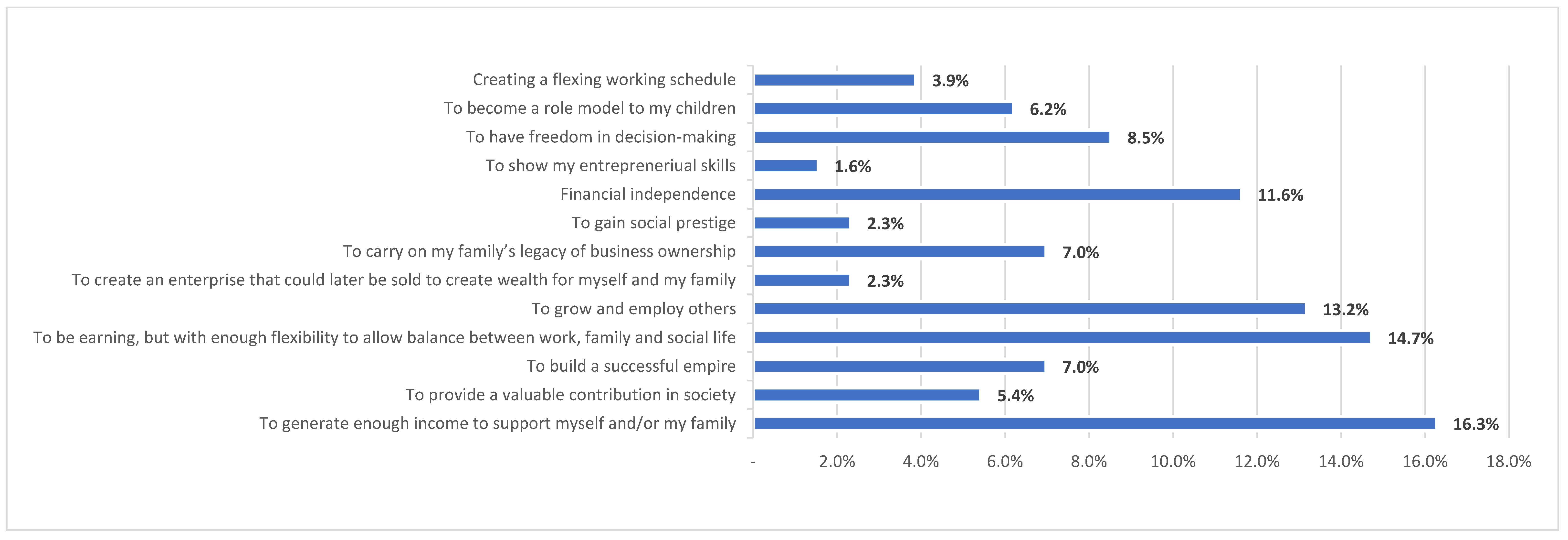
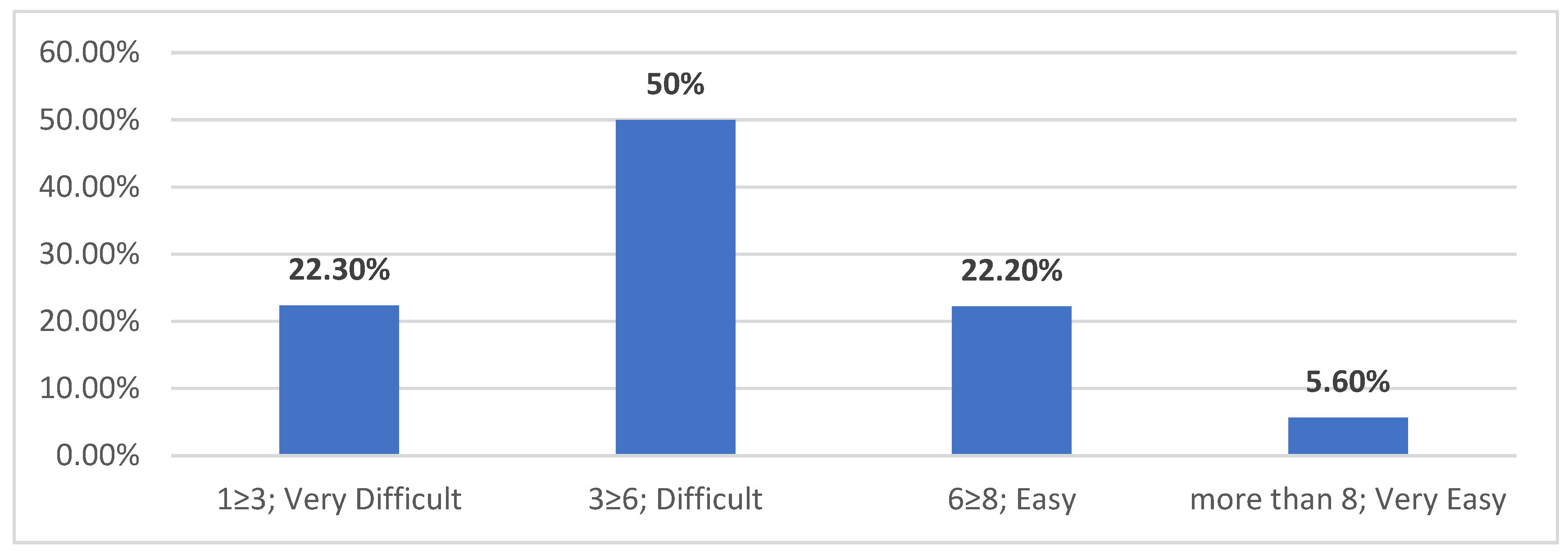
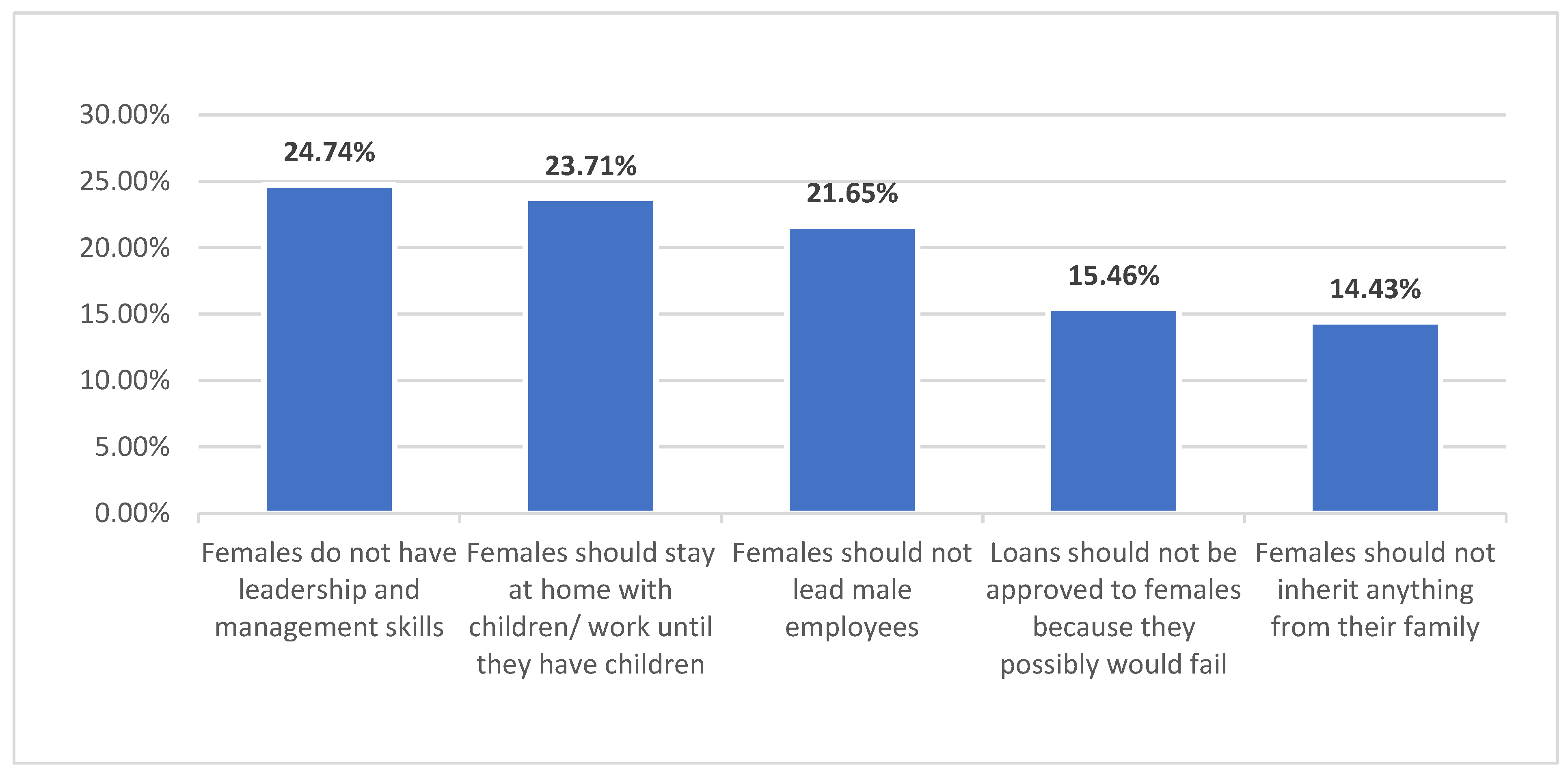
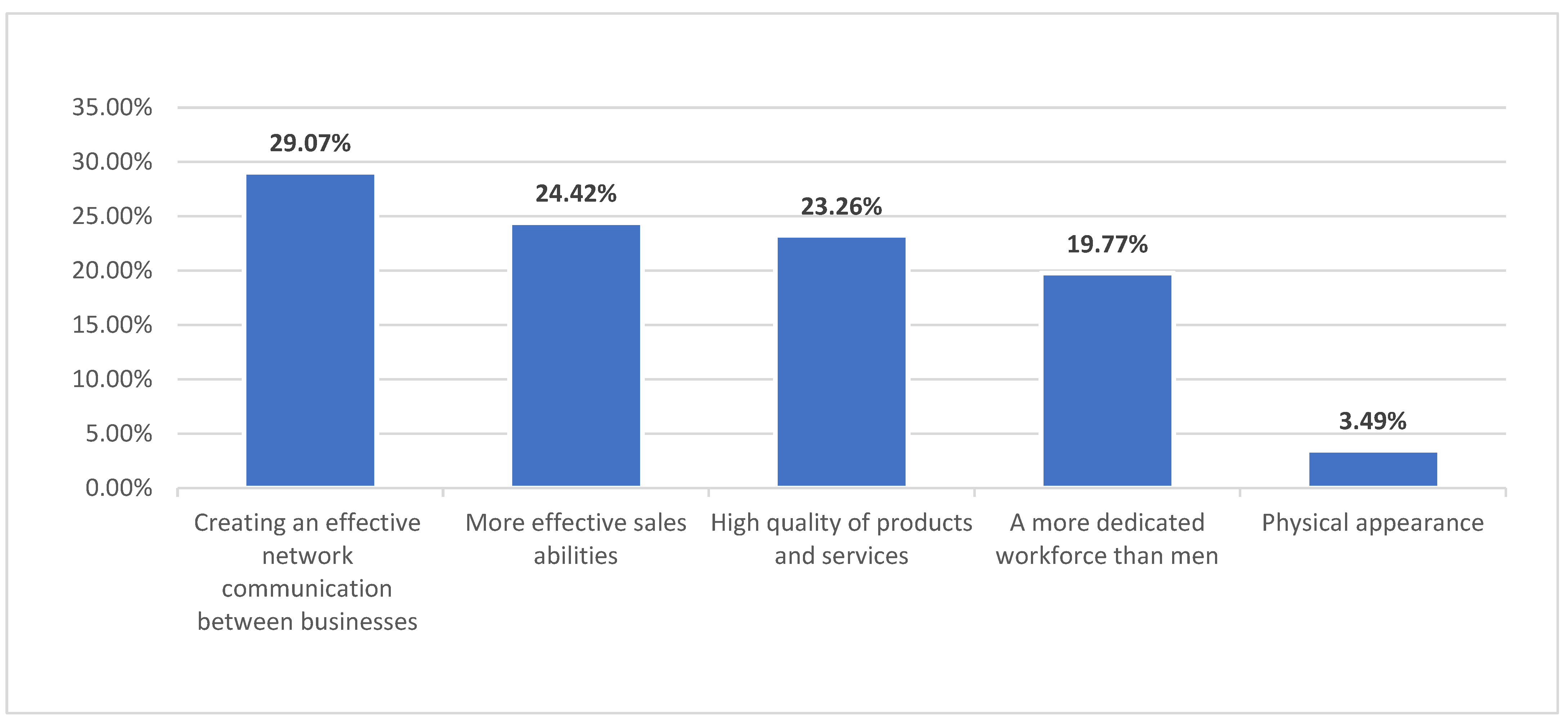

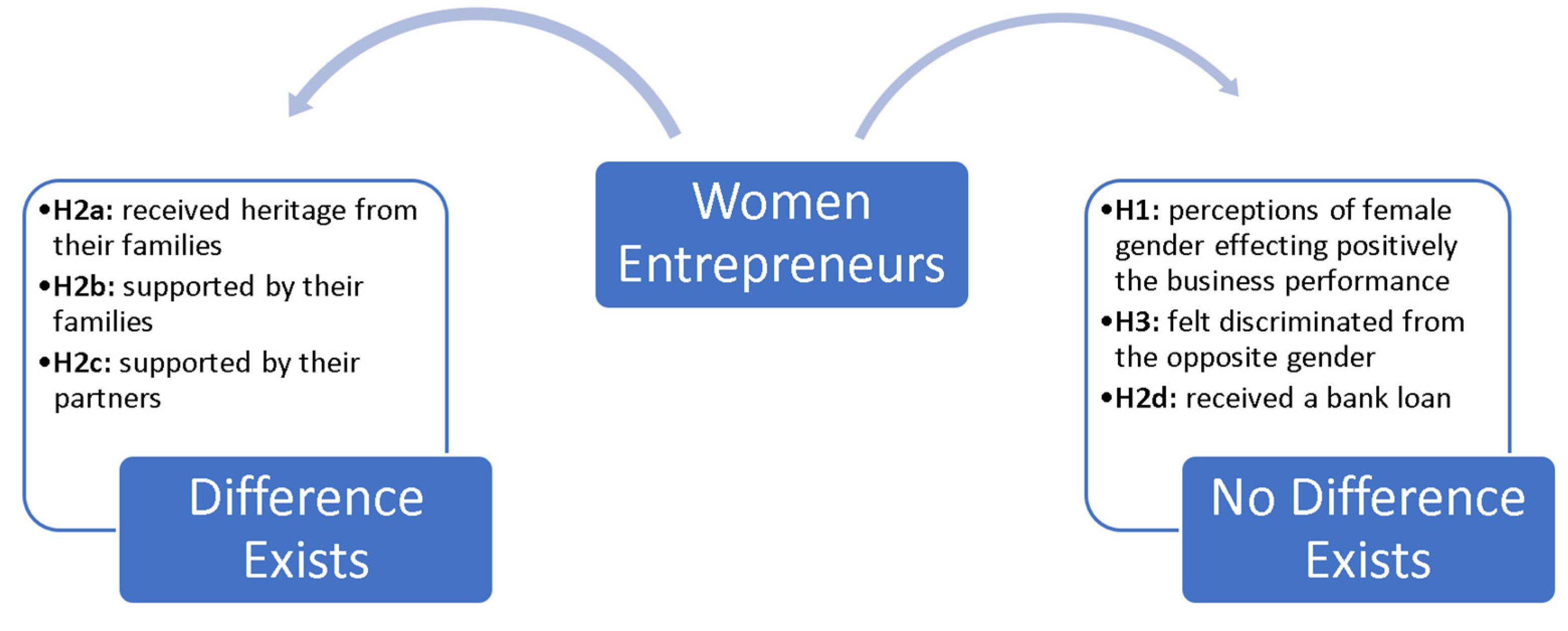
| Total | |||
|---|---|---|---|
| N = 36 | (%) | ||
| Age | <20 years | 4 | 11.1% |
| Between 21 and 30 years | 27 | 75% | |
| Between 31 and 40 years | 3 | 8.3% | |
| Between 41 and 50 years | 2 | 5.6% | |
| Family Entrepreneurship Background | Yes | 25 | 69.4% |
| No | 11 | 30.6% | |
| Marital Status | Single | 25 | 69.4% |
| Married | 11 | 30.6% | |
| Kids | No | 17 | 47.2% |
| Between 1 and 3 | 15 | 41.7% | |
| >3 | 4 | 11.1% | |
| Business age | <1 year | 11 | 30.6% |
| Between 1 and 5 years | 18 | 50% | |
| Between 5 and 10 years | . | 2.8% | |
| Between 10 and 15 years | . | 2.8% | |
| Between 15 and 20 years | 12 | 13.9% | |
| Business Industry | Food and beverage | 7 | 19.4% |
| Fabric and garment | 3 | 8.3% | |
| Retail shop | 3 | 8.3% | |
| Beauty shop | 1 | 2.8% | |
| Pharmacy | 3 | 8.3% | |
| Jewelry and flower | 1 | 2.8% | |
| Other | 18 | 50% | |
| Total | |||
|---|---|---|---|
| N = 36 | (%) | ||
| Previous Job Status | Housewife | 1 | 2.8% |
| Private sector | 19 | 52.8% | |
| Public sector | 7 | 19.4% | |
| Never worked before | 9 | 25% | |
| Motivation for venturing into Business | Dissatisfied with the previous job | 3 | 8.3% |
| Support from family | 4 | 11.1% | |
| Support from government | 7 | 19.4% | |
| Interest in business | 12 | 33.3% | |
| Family business | 10 | 27.8% | |
| Total | ||
|---|---|---|
| N = 36 | (%) | |
| Capital resources | ||
| Own savings | 12 | 33.3% |
| Loan from family | 17 | 47.2% |
| Loan from banks | 3 | 8.3% |
| Inheritance | 1 | 2.8% |
| Others | 3 | 8.3% |
| Bank loan approval | ||
| Yes | 17 | 46.43% |
| No | 19 | 53.57% |
| Family support | ||
| Yes | 34 | 94.44% |
| No | 2 | 5.56% |
| Partner support | ||
| Yes | 28 | 78.13% |
| No | 8 | 21.88% |
| Gender discrimination | ||
| Yes | 18 | 50% |
| No | 18 | 50% |
| Female impact on growth of business performance | ||
| Yes | 22 | 61.11% |
| No | 14 | 38.89% |
| Employees’ male/female ratio | ||
| Male dominant | 10 | 27.78% |
| Female dominant | 13 | 36.11% |
| Equal | 13 | 36.11% |
| Hypothesis | H1 | H2a | H2b | H2c | H2d | H3 |
|---|---|---|---|---|---|---|
| Chi-Square | 2.189 a | 4.568 a | 29.432 a | 10.939 b | 0.310 c | 0.027 a |
| df | 1 | 1 | 1 | 1 | 1 | 1 |
| Asymp. Sig. | 0.139 | 0.033 | 0.000 | 0.001 | 0.577 | 0.869 |
Disclaimer/Publisher’s Note: The statements, opinions and data contained in all publications are solely those of the individual author(s) and contributor(s) and not of MDPI and/or the editor(s). MDPI and/or the editor(s) disclaim responsibility for any injury to people or property resulting from any ideas, methods, instructions or products referred to in the content. |
© 2023 by the authors. Licensee MDPI, Basel, Switzerland. This article is an open access article distributed under the terms and conditions of the Creative Commons Attribution (CC BY) license (https://creativecommons.org/licenses/by/4.0/).
Share and Cite
Ahmetaj, B.; Kruja, A.D.; Hysa, E. Women Entrepreneurship: Challenges and Perspectives of an Emerging Economy. Adm. Sci. 2023, 13, 111. https://doi.org/10.3390/admsci13040111
Ahmetaj B, Kruja AD, Hysa E. Women Entrepreneurship: Challenges and Perspectives of an Emerging Economy. Administrative Sciences. 2023; 13(4):111. https://doi.org/10.3390/admsci13040111
Chicago/Turabian StyleAhmetaj, Bardhyl, Alba Demneri Kruja, and Eglantina Hysa. 2023. "Women Entrepreneurship: Challenges and Perspectives of an Emerging Economy" Administrative Sciences 13, no. 4: 111. https://doi.org/10.3390/admsci13040111
APA StyleAhmetaj, B., Kruja, A. D., & Hysa, E. (2023). Women Entrepreneurship: Challenges and Perspectives of an Emerging Economy. Administrative Sciences, 13(4), 111. https://doi.org/10.3390/admsci13040111







